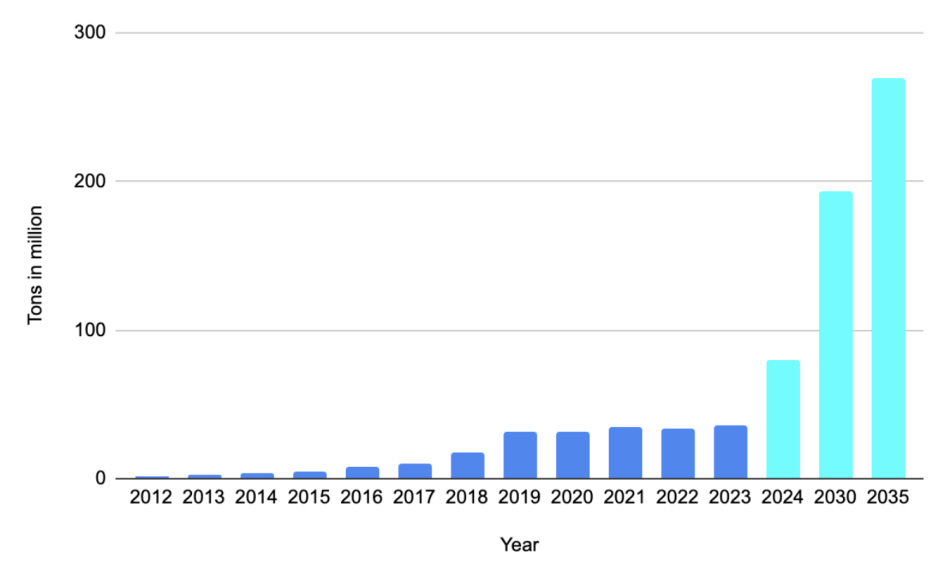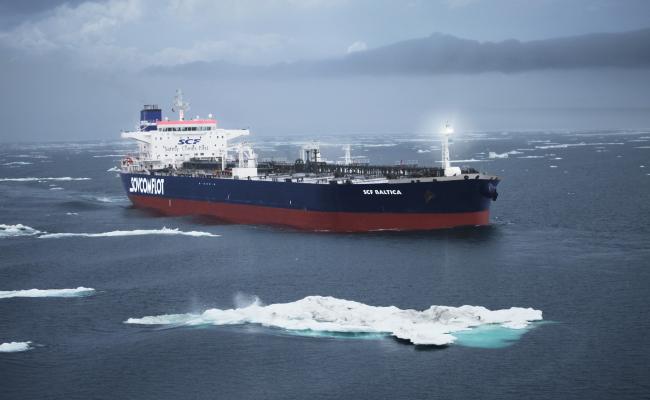Russia Says Northern Sea Route To Transport 270m tons by 2035

Rosatom nuclear icebreaker Vaigach escorting cargo ships in the Yenisei Bay. (Source: Rosatomflot)
Traffic on the Northern Sea Route will grow exponentially over the coming decade according to latest figures by Russian officials. The next boost in volume will come as early as 2024 with tonnage doubling from 40m to 80m tons.
Russia continues to release increasingly ambitious figures for the development of the Northern Sea Route (NSR). According to the latest forecasts by Rosatom the route will see 270m tons of cargo in 2035. This would be a nearly ten-fold increase over 2022.
In comparison, the Suez Canal, one of the world’s busiest shipping routes, saw 1.27bn tons of cargo throughput in 2022. Just a few years ago, estimates that the Arctic could see 20 percent of the cargo volume of the Suez Canal would have seemed outlandish, but Russian officials insist that these forecasts are very much achievable.
Russias state atomiс energy corporation, Rosatom’s special representative for the development of the Arctic, Vladimir Panov, presented these latest figures to parliamentarians of the Yamalo-Nenets Autonomous Okrug district.
"According to the agreements that have been signed with all major shippers to date, the plans for 2030 are 193 million tons, which exceeds the previous target of 150 million tons, and for 2035 we are already going beyond 220 million tons with a new target of 270 million tons,” Panov stated.
He further detailed the number of escorts Rosatomflot - the Russian nuclear icebreaker fleet - will conduct in the coming years as the nuclear icebreaker fleet continues to expand. For 2024 the company expects to provide services to 1,747 commercial voyages. That figure will increase to 3,381 by 2023 and 3,895 by 2035.
A big test will come next year for which Russian officials continue to predict 80m tons of cargo along the route. Achieving those figures will largely depend on natural gas producer Novatek’s ability to begin production at Arctic LNG 2 and progress at the Russian oil company Rosneft’s Vostok Oil project.

Cargo volume on the NSR between 2012 and 2023 and forecasts for 2024, 2030, and 2035. (Source: Author’s own work)
Need for lots of Arctic-capable ships
The ability to achieve this level of activity will in part depend on the Russian shipbuilding sector to deliver ice-capable vessels. Panov detailed that currently 29 ice-class cargo ships, including Arc4-7 oil and liquid natural gas (LNG) carriers, exist with a further 41 ships under construction.
An additional 88 ships will have to be built on top to reach the target number of 158 Arctic-suitable ships.
Deputy Prime Minister Alexander Novak cited similar figures, saying that by 2030 the Arctic cargo fleet would consist of 132 high ice-class vessels.
“This is a serious challenge for our shipbuilding industry,” Panov confirmed.
Unlocking immense value
The development of the NSR holds vast economic promise for Russia. According to Novak, the development resources along the route will boost Russia’s GDP by $370bn, or about 20 percent, by 2035. Arctic hydrocarbon resources will also bring in around $122bn in additional tax revenue over the next decade.
Novak explains that the government is looking to develop a fleet of smaller icebreakers as part of a cost-sharing scheme with industry. These lighter vessels would help keep open shipping lanes in the western part of the NSR freeing up the services of the more capable nuclear icebreakers to keep traffic along the eastern part flowing.
This will free up the more powerful nuclear icebreakers.
By 2030 a fleet of nine nuclear icebreakers and four powerful conventional icebreakers will operate up and down the NSR.
“The possibility of building six additional icebreakers of the Icebreaker 8-9 class at the expense of investors to operate near the ports and terminals of the Western part of the NSR at the mouth of the Yenisei River and in the Gulf of Ob is being explored. This will free up the more powerful nuclear icebreakers for operation in the Eastern sector of the NSR. Construction of the first four additional icebreakers are planned before 2030,” Novak stated.
Capturing traffic from the Suez Canal
As for the impact on global cargo flows, Rosatom expects to capture around 10 percent of cargo that previously flowed through the Suez Canal.
“The most important issue is regular year-round navigation, and that it has guaranteed speeds. This task will be solved for sure in the next 10 years. For this, a nuclear-powered icebreaker of the Leader class is being built. I hope, in December 2027 we will be able to confidently say that we have regular year-round navigation," stated Director of the NSR at Rosatom, Vyacheslav Ruksha.
The 120MW Leader-class icebreaker will be able to break through four meters of ice continuously and open up a shipping channel 60 meters across, wide enough for even the biggest oil and gas carriers.



